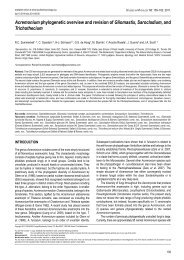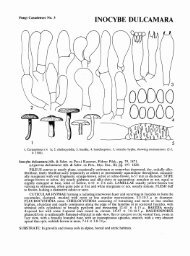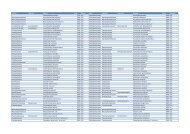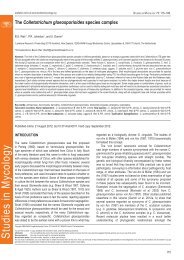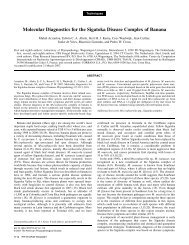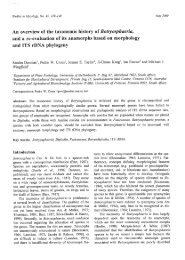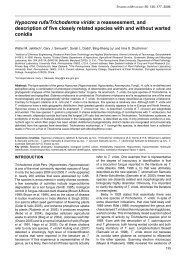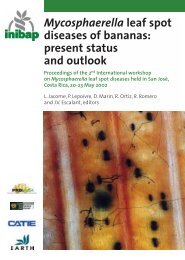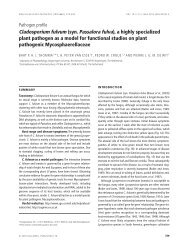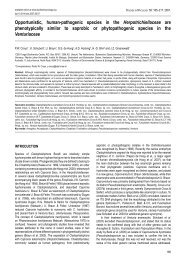Phylogenetic lineages in the Capnodiales - Cbs - KNAW
Phylogenetic lineages in the Capnodiales - Cbs - KNAW
Phylogenetic lineages in the Capnodiales - Cbs - KNAW
You also want an ePaper? Increase the reach of your titles
YUMPU automatically turns print PDFs into web optimized ePapers that Google loves.
crouS et al.<br />
that ascospores are always brown at maturity, and anamorphs have<br />
brown, percurrently proliferat<strong>in</strong>g conidiogenous cells, appear<strong>in</strong>g<br />
Phaeophleospora-like. The recognition of Brunneosphaerella<br />
as a dist<strong>in</strong>ct genus <strong>in</strong> <strong>the</strong> Mycosphaerellaceae also raises <strong>the</strong><br />
<strong>in</strong>trigu<strong>in</strong>g possibility that many phytopathogenic species of <strong>the</strong><br />
Leptosphaeria-complex with brown, 3-septate ascospores, but<br />
lack<strong>in</strong>g paraphyses, actually belong to Brunneosphaerella.<br />
Passalora agerat<strong>in</strong>ae Crous & A.R. Wood, sp. nov. Myco-<br />
Bank MB514697. Fig. 5.<br />
Etymology: Named after <strong>the</strong> host on which it occurs, Agerat<strong>in</strong>a<br />
adenophora.<br />
Passalorae assamensis similis, sed coloniis amphigenis, s<strong>in</strong>e mycelio externo,<br />
conidiophoris brevioribus, 15–40 × 3–4.5 µm.<br />
Leaf spots amphigenous, angular to irregular, 2–8 mm diam,<br />
medium brown, frequently with pale to grey-brown central part,<br />
and raised, dark brown border; pale to medium brown <strong>in</strong> reverse,<br />
with raised, dark brown border. Mycelium <strong>in</strong>ternal, consist<strong>in</strong>g of<br />
smooth, branched, pale brown, 2–3 µm wide hyphae. Caespituli<br />
fasciculate, amphigenous, medium brown, aris<strong>in</strong>g from a brown,<br />
erumpent stroma, up to 80 µm wide, 40 µm high. Conidiophores<br />
subcyl<strong>in</strong>drical, straight to geniculous-s<strong>in</strong>uous, unbranched,<br />
medium brown, f<strong>in</strong>ely verruculose, 1–3-septate, 15–40 × 3–4.5<br />
µm. Conidiogenous cells term<strong>in</strong>al, pale to medium brown, f<strong>in</strong>ely<br />
verruculose with term<strong>in</strong>al, sympodial conidiogenous loci that are<br />
1–2 µm diam, slightly thickened, darkened and refractive, 10–20 ×<br />
3–4 µm. Conidia <strong>in</strong> unbranched cha<strong>in</strong>s, pale brown, smooth, f<strong>in</strong>ely<br />
to prom<strong>in</strong>ently guttulate, subcyl<strong>in</strong>drical to narrowly obclavate, apex<br />
obtuse, base long obconically subtruncate, (0–)1–3(–5)-septate,<br />
(20–)30–60(–80) × (3–)4(–4.5) µm; hila 1–1.5 µm wide, somewhat<br />
thickened, darkened and refractive.<br />
34<br />
Culture characteristics: On MEA erumpent, with uneven, folded<br />
surface, lobate marg<strong>in</strong>, and moderate aerial mycelium; centre pale<br />
mouse-grey with patches of c<strong>in</strong>namon, outer marg<strong>in</strong> olivaceousgrey;<br />
reverse olivaceous-grey with patches of c<strong>in</strong>namon; reach<strong>in</strong>g<br />
15 mm diam; on PDA spread<strong>in</strong>g, with c<strong>in</strong>namon to cream patches<br />
<strong>in</strong> centre, becom<strong>in</strong>g umber towards smooth marg<strong>in</strong>s, with diffuse<br />
red pigment <strong>in</strong> agar; reverse olivaceous-grey, with patches of<br />
red, reach<strong>in</strong>g 15 mm diam; on OA flat, spread<strong>in</strong>g, up to 30 mm<br />
diam, iron-grey, with white, solitary mycelia strands, though aerial<br />
mycelium generally absent, reach<strong>in</strong>g 30 mm diam.<br />
Host range and geographic distribution: Agerat<strong>in</strong>a adenophora,<br />
Australia, South Africa.<br />
Specimen exam<strong>in</strong>ed: south Africa, KwaZulu-Natal Prov<strong>in</strong>ce, Hilton, on leaves of<br />
Agerat<strong>in</strong>a adenophora, 28 May 2008, A.R. Wood, CBS H-20336 holotype, cultures<br />
ex-type CPC 15365 = CBS 125419, CPC 15366, 15367.<br />
Notes: Agerat<strong>in</strong>a adenophora (crofton weed; Asteraceae), which<br />
is <strong>in</strong>digenous to Mexico, has <strong>in</strong>vaded many countries as a rapidly<br />
grow<strong>in</strong>g weed, form<strong>in</strong>g dense thickets (Morris 1989, Parsons &<br />
Cuthbertson 1992, Wagner et al. 1999, Zhu et al. 2007, Muniappan<br />
et al. 2009). It is considered a serious weed <strong>in</strong> agriculture and<br />
forestry (Bess & Haramoto 1958, Sharma & Chhetri 1977, Kluge<br />
1991), often replac<strong>in</strong>g more-desired vegetation or native species.<br />
A leaf spot pathogen, orig<strong>in</strong>ally misidentified as Cercospora<br />
eupatorii (this species is currently known as Pseudocercospora<br />
eupatorii), was found to <strong>in</strong>fect plants <strong>in</strong> Australia where a stem<br />
gall<strong>in</strong>g fly (Procecidochares utilis; Tephritidae) was <strong>in</strong>troduced from<br />
Hawaii as a biological control agent (Dodd 1961). Presumably <strong>the</strong><br />
fungus was <strong>in</strong>troduced toge<strong>the</strong>r with <strong>the</strong> flies orig<strong>in</strong>ally from Mexico<br />
to Hawaii and <strong>the</strong>n to Australia. Subsequently this same fungus<br />
was obta<strong>in</strong>ed from Australia and released <strong>in</strong> South Africa after<br />
host specificity test<strong>in</strong>g <strong>in</strong>dicated it was restricted to A. adenophora<br />
Fig. 5. Passalora agerat<strong>in</strong>ae. A. Leaf spots. B. Close up of leaf spot with fruit<strong>in</strong>g structures. C–D. Conidiophores. E–J. Conidia. Scale bars = 10 µm.




